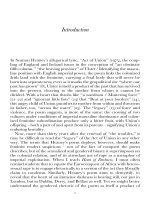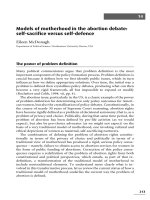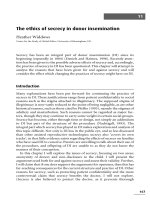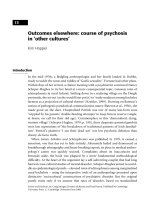Outcomes elsewhere - course of psychosis in ‘other cultures’
Bạn đang xem bản rút gọn của tài liệu. Xem và tải ngay bản đầy đủ của tài liệu tại đây (118.85 KB, 19 trang )
13
Outcomes elsewhere: course of psychosis
in ‘other cultures’
Kim Hopper
Introduction
In the mid-1970s, a fledgling anthropologist and her family landed in Dublin,
ready to tackle the runes and riddles of ‘Gaelic sexuality’. Fortune had other plans.
Within days of her arrival, a chance meeting with a psychiatrist convinced Nancy
Scheper-Hughes to try her hand at a more consequential topic, runaway rates of
schizophrenia in rural Ireland. Settling down in a seafaring village on the Dingle
peninsula, she set out (as she would later put it) to ‘study madness among bachelor
farmers as a projection of cultural themes’ (Kreisler, 1999). Drawing on Bateson’s
notion of pathogenic paradoxical communication snares (Bateson et al., 1956), she
made good on the dare. Hospitalised Patrick was one of many last-born sons
‘crippled by his parents’ double-binding attempts’ to keep him in reserve (single,
at home, on call for their old age). Commonplace in this ‘demoralised, dying,
western village’ (Scheper-Hughes, 1979, p. 190), these desperate parental gambits
were late expressions of ‘the breakdown of traditional patterns of Irish familial-
ism’. Patrick’s plaintive ‘I am their dead son’ was less psychotic delusion than
dreary, de facto truth.
When Saints, Scholars and Schizophrenics was published in 1979, it caused a
sensation, one that has yet to fade entirely. Alternately hailed and denounced as
breakthrough ethnography and heart-breaking expos
´
e, its place in medical anthro-
pology’s canon was quickly secured. Complaints about its inaccuracies and
betrayals aside, the book was plagued by a more fundamental methodological
difficulty. At the heart of the argument lay a self-subverting couplet that had long
harried cross-cultural studies of mental disorder. Scheper-Hughes aimed to unrid-
dle an epidemiological puzzle – elevated rates of schizophrenia among marginalised
rural bachelors – using the interpretive tools of an anthropology premised upon
distinctive ‘sociocultural’ constructions of psychiatric disorder. But the original
puzzle exists only if we assume that rates of disorder, based on standardised
Society and Psychosis, ed. Craig Morgan, Kwame McKenzie and Paul Fearon. Published by Cambridge
University Press. # Cambridge University Press 2008.
assessments of pathology, can legitimately be subjected to cross-cultural inquiry. In
effect, the logic that makes for the arresting anomaly was itself called into question
by the tools used to unravel it.
In this instance, prosaic artefactual realities would ultimately do in elegant
ethnographic theorising, as the author herself (to her credit) later acknowledged.
In the 20th anniversary edition of Saints, Scholars and Schizophrenics, Scheper-
Hughes reviews critical responses to the book that convincingly demolish its
starting premise. What looked like elevated rates of schizophrenic disorder were
in fact the false flags of unreliable hospital records and the catch-all nature of
psychiatric facilities as ‘indiscriminate repositories of social problems’ (Finnerty
et al., 2007). More rigorous examinations of the data did show that these celibate
denizens of blighted rural areas were prone to higher rates of depression and
suicide, and Scheper-Hughes revises her account accordingly. But the original
puzzle is still cultural in nature. Like the asylum in nineteenth century America
(or, for that matter, in colonial Nigeria (Sadowsky, 1999, p. 53)), the Irish hospital
was a multipurpose facility prone to misuse, ‘a convenient way of getting rid of
inconvenient people’ (Scull, 1977, p. 33). The whole assemblage of double count-
ing, slipshod records, extended lengths of stay and elastic diagnoses had to be taken
sceptically and read sociologically. The ethnographic question had less to do with
psychopathology than with what made this institutional option acceptably con-
venient, a question with which anthropologists continue to grapple (Biehl, 2005;
Saris, 1996). Scheper-Hughes’ stranded bachelors, like their counterparts in south-
western France (Bourdieu and Wacquant, 1992, p. 165), may have been ‘caught
between old and new social systems and moral economies’ (Scheper-Hughes,
2000, p. 49), but they were not, by that token alone, on the road to madness. At
the same time, she insisted that the damaged men of An Cloch
´
an – not just those
hospitalised, but those whose profound strangeness and heartbreaking isolation
were locally tolerated – are specific casualties, of a hard time and unbending place,
with signifying value.
But precisely how should they signify? Psychiatry has generally favoured the
epidemiological road in answering that question, plying an ever more refined
technology of comparative analysis to assess local incidence and outcome of well
defined disorders. In that sweeping cross-cultural enterprise, one anomaly has held
firm since it first appeared in the 1960s: the claim that persons with schizophrenia
in ‘developing’ countries consistently enjoyed better outcomes than their counter-
parts in more ‘developed’ settings. How well has that evidence stood the test of
time? And how, in any event, should we read it? But a second, less prominent (even
self-effacing) interpretive tradition takes another route. Like Scheper-Hughes –
unrepentant for all her travails, revising on the spot to pry signifying value out
of reworked epidemiological data – these anthropological analysts are more
199 Outcomes elsewhere
concerned with meaning and practice than with rates and measures. Forlorn,
dishevelled, lost not least of all to themselves, local madmen (though not all of
them and not all of the time) may be figures of prophetic import. Wittingly or not,
mute or frenzied, heeded or ignored, such people offer critical commentary shaped
by their own trying times and tuned to the fault-lines of their fractious cultures.
The analyst’s job is to hear and decipher it. If cultures are arguments over what
kind of collective life a people will commit to (Douglas, 2004, p. 94), then some of
the mad, some of the time, constitute a defecting Greek chorus of one, declaiming
what may be painfully obvious from without if invisible (or forbidden) from
within. Discredit and dismissal are the usual price they pay for the dubious
privilege. What might we learn from this alternative, sectarian tradition of reading
outcome differently?
The epidemiological record
Upbeat descant to the descending bass-line of progressive deterioration in the
West, the course of schizophrenia in ‘other cultures’ has long claimed pride of
place among the curiosities of cross-cultural psychiatry, a stature neither wholly
earned (rates of recovery in the West are by no means uniformly bad) nor
unanimously subscribed to (indeed, it is one of the favoured targets of sceptical
commentators). Before reviewing the untidy particulars of that story, however, it is
worth noting how durable the caricatures in this call-and-response have proven.
On the one hand, molecular myopia can lead some researchers to make (what
seem) wilfully uninformed pronouncements such as this one: ‘Once the symptoms
of schizophrenia occur (usually in young adulthood) they persist for the entire
lifetime of the patient and are almost totally disabling’ (Sawa and Snyder, 2002,
p. 692). On the other hand, the WHO international outcome studies are some-
times misread as damning witness to Western psychiatry’s single-handed reliance
on medication, which is then taken to explain the poor showing of ‘developed’
centres in that research (Whitaker, 2001). Neurobiological determinism faces off
against psychopharmacological imperialism. Neither troubles itself with the bulk
of evidence inconveniently lying elsewhere.
The rumour of recovery from schizophrenia in other cultures made innocent
rounds in early ethnographic circles only to be roundly discredited in clinical
corridors. It took two forms. The first, ignorant (or dismissive) of Kraepelin’s
(1919) own south-east Asian reconnaissance in the early twentieth century, alleged
low (or no) incidence of severe psychopathology in traditional societies, even
while recognising idiopathic (culture-specific) disorders (Faris, 1934). For these
investigators, in Demerath’s (1942, p. 703) mocking formula, ‘The functional
pathologies are the peculiar curse of civilised man.’ Course of illness was
200 K. Hopper
immaterial when incidence was near zero. Such bold speculation, built on an
admittedly thin evidentiary base, was countered strongly by reports suggesting
that the notion of idyllic pathology-free regions was wistful fiction (Laubscher,
1937; Winston, 1934). But tantalising inconsistency was the rule (Gillin, 1939). For
every dogmatic assertion, a sceptical demurral could also be found. Lopez (1932)
reported that schizophrenia was indeed found among displaced Brazilian Indians
living on the coast, but not in the then-undisturbed interior. Seligman (1929)
found no insanity in untouched Papua New Guinean villages, but definite
instances in those where ‘white influence’ was felt. Benedict (1934) described
whole cultures built on routine trafficking between dream and everyday realities.
And Mead reported that the imported wives of Manus men in the Admiralty
Islands are ‘noticeably schizoid’; such women were ‘taken from their own villages
to live among the people of their husbands and in that group they are always
outsiders’ (recounted by Faris, 1934, p. 31, emphasis added).
Overreaching aside, the field validity of specific reports was hard to contest.
Aggregated and more attentive to methods, they took on more persuasive power.
By mid-century, variation in the ‘true’ community prevalence of severe disorders
was apparent even in European studies (Hammer and Leacock, 1961). The argu-
ment had undeniable relativist appeal: that what we don’t see, even on close
sustained examination, may be telling us both that it doesn’t occur and to look
elsewhere to detect trace effects. What derails reason on the home front may be
otherwise accommodated elsewhere. How else to account for the argument, made
by an NIMH researcher (the same year WHO launched the International Pilot
Study of Schizophrenia), that the occupational availability of shamanism in some
cultures may channel disruptive identity crises that might otherwise find expres-
sion as reactive schizophrenia (Silverman, 1967)? In such settings, resolution of
these nominally ‘psychotic’ episodes is ‘effectively channelled by the prevailing
institutional structures or may perform a given function in relation to the total
culture’ (Silverman, 1967, p. 23). Like the ‘mazeway resynthesis’ earlier proposed
as the breakthrough ordeal of the protagonist of a cultural revitalisation move-
ment among the Seneca Indians, the success of extreme states of reintegration
depends on ‘both the resources of the individual and the support his effort is given
by the community’ (Wallace, 1961, p. 192).
The second version frankly admitted that phenotypically close approximations
of garden-variety (Western) psychoses can be found almost everywhere, and went
on to make the case for qualitatively better outcomes in more traditional societies.
Murphy and Raman’s (1971) 12-year follow-up study in Mauritius set the stage for
what the suite of WHO studies would shortly (and problematically) establish: that
in pre-industrial cultures, ‘acute, short-lasting psychosis’– indistinguishable from
textbook schizophrenia but for its brief course and good prognosis – may be the
201 Outcomes elsewhere
rule. What further distinguished this study was its attention to comparative rigour.
Per capita hospital bed rates were roughly on a par with European ones (but
treatment was a decade behind and aftercare non-existent), only first admissions
were included, and follow-up assessments were intensive and standardised. The
upshot: nearly two-thirds (60%) of the Mauritian cohort ‘were functioning nor-
mally ... and had no history of relapses in the period since leaving hospital’
(Murphy and Raman, 1971, p. 495). The comparable rate in the closest British
equivalent (Brown, 1966), a 5-year follow-up study, was at best 40%. Intriguingly,
somewhat less than a third of both samples showed continuous, crippling illness.
Murphy and Raman hypothesised that, facilitating factors in Mauritius aside, the
less severe (and better prognosis) European patients may be ‘trapped’ in chronicity
by an incapacitating sick role. The lingering effects of ‘institutionalism’ among
discharged patients of that era offer indirect corroboration (Wing and Brown,
1970).
For their part, the WHO studies (Harrison et al., 2001; Hopper et al., 2007a;
Jablensky et al., 1992; WHO, 1973, 1979) have consistently shown (with a few
exceptions) that both short-term and long-term courses favoured subject cohorts
in ‘developing’ centres. The finding is remarkably robust. It extends across three
generations of WHO collaborative studies. It holds for brief and long-term follow-
up, for distinctive diagnostic groupings (ICD-9, converted to ICD-10 and all
psychoses), and for different groupings of ‘developed’ and ‘developing’ countries.
And, by one reckoning, the differential is relatively constant – an odds of recovery
ratio of roughly 1.5 favouring the non-industrial group.
During this period, too, independent reports from other ‘developing’ regions
continued to appear, employing a host of methods and making for a decidedly
mixed picture (e.g., Kebede et al., 2005; Kurihara et al., 2000; Ran et al., 2001). If a
salient impression were to be hazarded from this assortment, it would be some-
thing like this: be wary of glib optimism in relation to outcomes elsewhere. Clinical
status (especially among untreated cohorts) is likely to be poor, even when coupled
with high, necessity-driven rates of social functioning. But these are neither long-
term nor fully reported, in the main. Cohort studies are expensive, logistically
demanding, and require extensive training and coordination over time; not
surprisingly, few get done.
How to take stock of so varied and contentious a legacy? For our purposes, a
recent authoritative review captures the difficulty neatly. As Bresnahan and col-
leagues (2003) assess the evidence, ‘It appears that some aspect of the economic or
cultural circumstance in developing countries may provide a more therapeutic
context for recovery’ (p. 29). They go on to round up the ‘usual suspects’
commonly assembled to operationalise (if only plausibly) that nondescript phrase
‘some aspect’ – involved families present for the long haul, informal economies
202 K. Hopper
and flexible work demands, desegregated treatment and community cohesion.
Conspicuously absent is treatment, and that (as we will see) may be an unwar-
ranted omission.
At the same time, it would be unwise to ignore persistent criticisms of the WHO
studies. Nagging questions have been raised about selection bias (‘leakage’ in case
identification), diagnostic elasticity (over-inclusion of reactive psychoses, with
better prognosis, in developing centres), unacceptable rates of drop-out in devel-
oping centres, anecdotal accounts of gross mistreatment and searing stigma, crude
classification of participating cohorts as ‘developed’ and ‘developing’, and black-
boxing of culture. Some of these objections, those pertaining to potential con-
founds owing to composition of cohorts or follow-up irregularities, have been
addressed by strong-inference analyses of the long-term results of the International
Study of Schizophrenia (ISoS) (Hopper and Wanderling, 2000). Others go yet
unanswered.
Consider ‘culture’. For all the potential explanatory power packed into the
concept, it becomes clear that ‘culture’ is both a constant presence in the WHO
corpus and a ghostly one, nimbly stepping in to claim (if not account for)
otherwise ‘unexplained variance’ (Edgerton and Cohen, 1994; Hopper, 2003).
The WHO investigators have wisely skirted the long-running civil wars in anthro-
pology over its meaning and use, but a working notion of culture is discernible in
the write-ups themselves and their contending interpreters. Off-stage but ever-
hovering, an insistent prompt and script-doctor, culture provides both institu-
tional armature and internalised programme for collective living. It puts in place a
local moral world and its array of supporting practices within which an illness
episode and its aftermath are embedded. This capacious understanding has long
made for profligate, if not always well specified or documented, hypotheses for
why outcomes elsewhere are better: exculpatory beliefs, less-complex cognitive
demands, extended family support, accommodating work regimens, absent stigma
(Cohen, 1993; Cooper and Sartorius, 1977; Hopper, 1991; Warner, 2003). But, as
Bresnahan and colleagues (2003) are careful to note (even as they rehearse the list),
evidence for these is uneven at best. Even were a factor to be shown to be relevant,
the messy, inevitably improvised particulars of how local culture works to shape
recovery, the detailed close-ups and extended exposures that the documentary
record would require to show how disability is averted and resumption of valued
social roles accomplished, remain missing – if for no better reasons than (1) the
epidemiological design of the studies was not up to the task and (2) relevant
secondary accounts are scarce.
But other factors are surely relevant, though they too have proven refractory to
focused, single-take documentation. If culture is both shaping and shifting, so too,
it turns out, is treatment. Of the two Indian sites that account for the ‘developing’
203 Outcomes elsewhere
country side of the ISoS divide, one is remarkable for the tenacity of its clinical
follow-up and both had conducted interim follow-up studies on their own
initiative. In one, as a side benefit of this research interest, subjects ‘were in close
contact with the centre and were very closely monitored’, their clinical status
and life circumstances were commonly known, and they ‘remained on active
follow-up and treatment’ (Varma and Malhotra, 2007, p. 125). At the other, the
Schizophrenia Research Foundation (SCARF, the Chennai research centre) is
renowned for its insistent attention to work and informed family involvement,
while its psychiatrists are unflinching in their adherence to a Western ‘biomedical
model’ of mental illness. Medications are provided free to poor patients (Miller,
2006; Thara et al., 2007). Aside from such well established clinical operations as
these, and much harder to include in the usual array of instruments and debrief-
ings that go into follow-up studies, are parallel or ‘complementary’ ethnomedical
and religious healing modalities. Plural treatment options and multiple therapeu-
tic use – sequentially or concurrently, if rarely with cross-consultation – are the
rule throughout South India (Campion and Bhugra, 1998; Kapur, 1979). In rural
areas, religious temples provide respite and asylum to people suffering from
disabling disorders; many people show marked improvement after (Pakaslahti,
1998; Raguram, 2002). Elsewhere, an ad hoc syncretism holds sway, driven prag-
matically by family treatment management teams. In Kerala, Halliburton’s (2004)
informants were families with afflicted members whose expressive and behavioural
features were strongly suggestive of psychosis: ‘nonsensical speech, flat affect,
delusions, repeated acts of violence and morbid self-neglect’ (p. 86). Interviewed
at various stages in their illness careers, they had sought treatment – and reported
differential relief – from Western (allopathic), ayurvedic and religious healers.
Obviously, this makes compiling an accurate record of interventions over time
difficult, to say nothing of apportioning beneficial effect.
Still, the most profound challenge to the robust ISoS irregularity of better
outcomes elsewhere may be the protest lodged by researchers, themselves experi-
enced students of and practitioners in their own ‘developing’ settings, who insist
that an approach that more accurately limned the full span of illness course and
consequence would yield a more faithful – and unsettling – picture of local realities
(Patel et al., 2006). This position challenges not only the hidebound orthodoxy of
neurobiological fundamentalism, but also the insurgent corrective that could be
read as finding therapeutic virtue in collective hardship. Empirically, the case is
compelling if still incomplete. Mortality among those diagnosed with schizophre-
nia with poor early course of illness can be highly elevated – by 47% in the rural
Chandigarh ISoS cohort (Mojtabai et al., 2001); by 17% over 20 years, less steep
but still high, in the Chennai cohort (Thara, 2004). Evidence of human rights
abuses, less systematically documented than wrenchingly recounted, is steadily
204 K. Hopper









